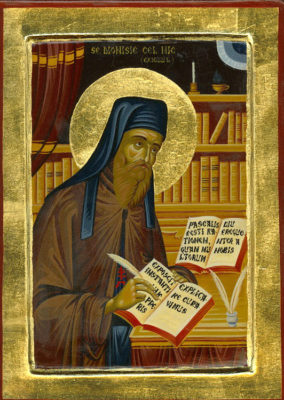
The terms anno Domini (AD) and before Christ (BC) are used when designating years in the Julian and Gregorian calendars. The term anno Domini is Medieval Latin and means "in the year of the Lord" but is often presented using "our Lord" instead of "the Lord", taken from the full original phrase "anno Domini nostri Jesu Christi", which translates to "in the year of our Lord Jesus Christ". The form "BC" is specific to English, and equivalent abbreviations are used in other languages: the Latin form, rarely used in English, is Ante Christum natum (ACN) or Ante Christum (AC).

Ab urbe condita, or anno urbis conditae, abbreviated as AUC or AVC, expresses a date in years since 753 BC, the traditional founding of Rome. It is an expression used in antiquity and by classical historians to refer to a given year in Ancient Rome. In reference to the traditional year of the foundation of Rome, the year 1 BC would be written AUC 753, whereas AD 1 would be AUC 754. The foundation of the Roman Empire in 27 BC would be AUC 727. The current year AD 2024 would be AUC 2777.
Common Era (CE) and Before the Common Era (BCE) are year notations for the Gregorian calendar, the world's most widely used calendar era. Common Era and Before the Common Era are alternatives to the original Anno Domini (AD) and Before Christ (BC) notations used for the same calendar era. The two notation systems are numerically equivalent: "2024 CE" and "AD 2024" each describe the current year; "400 BCE" and "400 BC" are the same year.
An era is a span of time defined for the purposes of chronology or historiography, as in the regnal eras in the history of a given monarchy, a calendar era used for a given calendar, or the geological eras defined for the history of Earth.
The Julian calendar is a solar calendar of 365 days in every year with an additional leap day every fourth year. The Julian calendar is still used as a religious calendar in parts of the Eastern Orthodox Church and in parts of Oriental Orthodoxy as well as by the Amazigh people.
AD 1 (I) or 1 CE was a common year starting on Saturday or Sunday, a common year starting on Saturday by the proleptic Julian calendar, and a common year starting on Monday by the proleptic Gregorian calendar. It is the epoch year for the Anno Domini (AD) Christian calendar era, and the 1st year of the 1st century and 1st millennium of the Christian and Common Era (CE).

Chronology is the science of arranging events in their order of occurrence in time. Consider, for example, the use of a timeline or sequence of events. It is also "the determination of the actual temporal sequence of past events".

The Coptic calendar, also called the Alexandrian calendar, is a liturgical calendar used by the Coptic Orthodox Church and also used by the farming populace in Egypt. It was used for fiscal purposes in Egypt until the adoption of the Gregorian calendar on 11 September 1875. This calendar is based on the ancient Egyptian calendar. To avoid the calendar creep of the latter, a reform of the ancient Egyptian calendar was introduced at the time of Ptolemy III which consisted of adding an extra day every fourth year. However, this reform was opposed by the Egyptian priests, and the reform was not adopted until 25 BC, when the Roman Emperor Augustus imposed the Decree upon Egypt as its official calendar. To distinguish it from the Ancient Egyptian calendar, which remained in use by some astronomers until medieval times, this reformed calendar is known as the Coptic or Alexandrian calendar. Its years and months coincide with those of the Ethiopian calendar but have different numbers and names.

Dionysius Exiguus was a 6th-century Eastern Roman monk born in Scythia Minor. He was a member of a community of Scythian monks concentrated in Tomis, the major city of Scythia Minor. Dionysius is best known as the inventor of Anno Domini (AD) dating, which is used to number the years of both the Gregorian calendar and the (Christianised) Julian calendar. Almost all churches adopted his computus for the dates of Easter.
A calendar era is the period of time elapsed since one epoch of a calendar and, if it exists, before the next one. For example, it is the year 2024 as per the Gregorian calendar, which numbers its years in the Western Christian era.

Roman Egypt was an imperial province of the Roman Empire from 30 BC to AD 641. The province encompassed most of modern-day Egypt except for the Sinai. It was bordered by the provinces of Crete and Cyrenaica to the west and Judaea, later Arabia Petraea, to the East.
Theophilus was the 23rd Pope of Alexandria and Patriarch of the Seat of Saint Mark. He became pope at a time of conflict between the newly dominant Christians and the pagan establishment in Alexandria, each of which was supported by a segment of the Alexandrian populace.
Annianus of Alexandria was a monk and writer who flourished in Alexandria during the pontificate of Theophilus I around the beginning of the 5th century.
The Ethiopian calendar, or Ge'ez calendar is the official calendar of Ethiopia. It is used as both the civil calendar and an ecclesiastical calendar. It is the liturgical year for Ethiopian and Eritrean Christians belonging to the Orthodox Tewahedo Churches, Eastern Catholic Churches, and Eastern Protestant Christian P'ent'ay Churches. The Ethiopian calendar is a solar calendar that has much in common with the Coptic calendar of the Coptic Orthodox Church of Alexandria and Coptic Catholic Church, but like the Julian calendar, it adds a leap day every four years without exception, and begins the year on 11 or 12th of September in the Julian calendar. A gap of seven to eight years between the Ethiopian and Gregorian calendars results from an alternative calculation in determining the date of the Annunciation.

Anno Mundi, abbreviated as AM or A.M., or Year After Creation, is a calendar era based on the biblical accounts of the creation of the world and subsequent history. Two such calendar eras have seen notable use historically:
A year zero does not exist in the Anno Domini (AD) calendar year system commonly used to number years in the Gregorian calendar ; in this system, the year 1 BC is followed directly by year AD 1. However, there is a year zero in both the astronomical year numbering system, and the ISO 8601:2004 system, the interchange standard for all calendar numbering systems. There is also a year zero in most Buddhist and Hindu calendars.

The Byzantine calendar, also called the Roman calendar, the Creation Era of Constantinople or the Era of the World, was the calendar used by the Eastern Orthodox Church from c. 691 to 1728 in the Ecumenical Patriarchate. It was also the official calendar of the Byzantine Empire from 988 to 1453 and of Kievan Rus' and Russia from c. 988 to 1700. This calendar was used also in other areas of the Byzantine commonwealth such as in Serbia, where it is found in old Serbian legal documents such as Dušan's Code, thus being referred to as the Serbian Calendar as well.
Anatolius of Laodicea, also known as Anatolius of Alexandria, was a Syro-Egyptian saint and Bishop of Laodicea on the Mediterranean coast of Roman Syria in AD 268. He was not only one of the foremost scholars of his day in the physical sciences, as well as in Aristotelian and Platonic philosophies, but also a renowned computist and teacher of the Neoplatonic philosopher Iamblichus.
This article lists people, events and other subjects which are referred to as "of Alexandria".
Since ancient times, traditional mathematics in Ethiopia have related to various aspects of astrology, the calendar, and measurements of physical properties such as length, weight, and distance. Ethiopians used alternate units of measurement which differ from fundamental law; traditionally, scaling and counting values have been described using draft animals such as goats, mules, sheep, or camels, and in modern times, steelyards.







